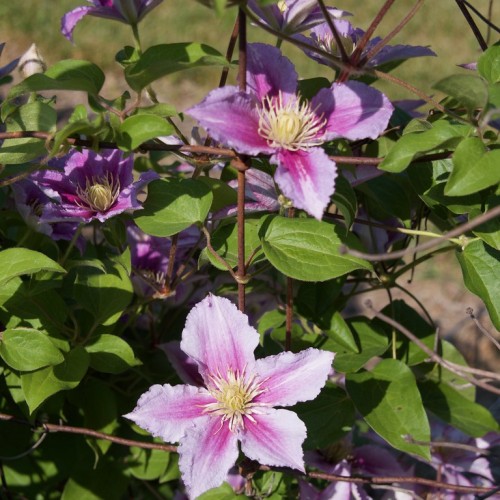
clematis
Clematis 'Nelly Moser'
Cycle:
Perennial
Watering:
Average
Hardiness Zone:
4 - 8
Flowers:
Flowers
Sun:
Full sun,part shade
Fruits:
Fruits Ready In Fall
Leaf:
Yes
Growth Rate:
High
Maintenance:
Low
Care Level:
Medium
watering
Clematis 'Nelly Moser' is best kept consistently moist but not overly wet. During the growing season (typically spring and summer) water it every 2-7 days depending on soil moisture and temperatures, making sure it is receiving at least 1 inch of water per week. Never leave the plant to dry out. Once temperatures start dropping during the fall months, give it less water, letting the top soil dry out in between waterings.
sunlight
Clematis 'Nelly Moser' needs at least 6 hours of direct sunlight per day during peak flowering season in summer. It should be placed in a spot where it will receive full sun in the morning, followed by partial or dappled shade in the afternoon. If it is in a particularly hot or dry area, then it may need a bit of extra water or light shade. During the winter months, it should receive at least 4 hours of indirect sunlight per day.
pruning
Clematis 'Nelly Moser' should be pruned at least once a year, typically in late winter or early spring. This pruning should remove any new or old dead growth and any stems that are growing too long or wayward. The remaining stems can be cut back to within 2 buds of the previous year's long stems. Doing so will encourage the plant to develop strong and robust new shoots.
FAQ
Can Clematis plants grow in pots?
Yes, Clematis plants can definitely be grown in pots. When planting a Clematis in a pot make sure to use a larger size pot with drainage holes and fill it with a mix of well-draining potting soil and compost. Ensure to keep the root area cool and the pot in a sunny location while providing regular water and fertilization. Check the plant almost daily to make sure it is not becoming too dry. Clematis can do well in a pot and with the right care and conditions, they will thrive.
Are Clematis plants self-pollinating?
No, clematis plants are not self-pollinating. Clematis plants need pollinators such as bees, butterflies, moths and other insects to transfer pollen from the male anthers to the female stigma of the flower in order to produce viable seed. Pollination must also occur within relatively close proximity of the same species in order to create viable hybrid plants.
Can Clematis plants be grown as a houseplant?
Yes, Clematis plants can be grown as a houseplant. It is best to grow them in a pot with full sun and a soil that is rich in organic material and retains moisture. When potting the plant, place a stake or trellis next to the pot so that the vine can climb when it begins to grow. Be sure to water your Clematis plant regularly to keep it healthy and growing. Additionally, keep an eye out for pests and treat with natural insecticides as necessary.
Could Clematis plants survive in a colder climate?
Yes, Clematis plants can survive in colder climates with proper preparation. If planted in the fall, proper mulching should be done to protect the roots from cold temperatures. If planted in the spring, they should be watered frequently to help them adjust to the cooler temperatures more quickly. If temperatures drop below -20°C ( -4°F), additional measures may need to be taken such as the application of protective wraps and thermal insulation. Additionally, plants in exposed areas should be protected from the wind to prevent excessive dehydration. With the right measures in place, Clematis plants can easily survive in colder climates.
Could Clematis plants be grown in a greenhouse?
Yes, clematis plants can be grown in a greenhouse. Due to their vine-like growth habit and tropical native origins, clematis plants thrive in the moist and warm environment of a greenhouse. Clematis are generally grown from cuttings or from dividing existing plants, and benefit from regular pruning and fertilizing. They will also enjoy the indirect light of a greenhouse and the protection from strong winds and temperatures that the humidity and contained environment provides.
